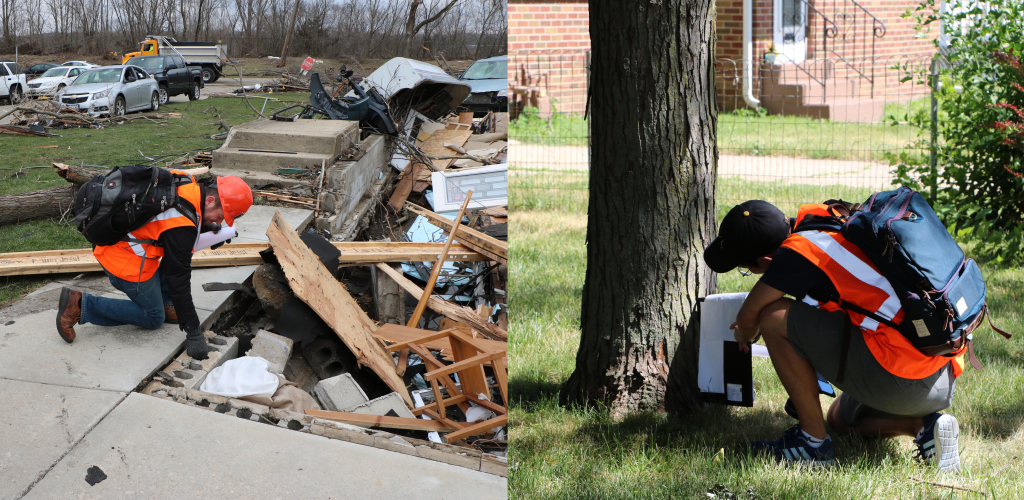Using tree-fall patterns to calculate tornado wind speed
 103rd Annual Meeting of the Ecological Society of America:
103rd Annual Meeting of the Ecological Society of America:
Extreme events, ecosystem resilience and human well-being
5–10 August 2018
June 22, 2018
For Immediate Release
Contact: Zoe Gentes, 202-833-8773 ext. 211, gro.asenull@setnegz
Tornadoes, hurricanes, and other extreme windstorm events cause millions of dollars in structural damage and related losses each year. They can also significantly damage ecosystems systems, driving efforts to study resilience in the face of these events. For any resilience study involving severe wind storms, an accurate estimate of wind speed is an essential. The initial damage inflicted on trees (or any ecosystem) changes for different wind speeds. These are difficult to ascertain, both in-situ or by radar measurements, during a severe windstorm event. A promising method using tree-fall patterns (i.e., the falling direction of trees) has been developed to estimate these speeds.
Tornado wind speed can be estimated by simulating a tornado using the Rankine Vortex model. The trees are assumed to fall if the wind speed generated by the tornado is greater than the critical wind speed of tree-fall, which creates distinctive tree-fall pattern. The critical wind speed of the tree-fall correlates with the thickness and height of the trees. Researchers ultimately try to simulate a pattern that closely matches the real life tornado tree-fall pattern.
Daniel M. Rhee, a PhD student at University of Illinois specializing in Structures in Civil Engineering, focuses his research on modeling tornadoes and near-surface wind speeds using tree-fall and damage patterns. With this method, Rhee and his research advisor, Franklin T. Lombardo, estimated the near-surface wind speeds of an actual tornado event in Naplate, IL. Rhee will present this research at the Ecological Society of America’s 2018 Annual Meeting in New Orleans, LA.

Lombardo (left) and Rhee (right) investigating trees and residential debris after a tornado tore through central Illinois in February 2017. Photo credit: Justin Nevill.
Tornadoes are rated by their intensity and the damage they cause to vegetation and structures. The Enhanced Fujita scale (EF-Scale) is a tornado scale that was originally introduced in 1971 (and later updated) by Tetsuya Fujita and Allen Pearson. Fujita researched windstorm destruction and also used tree-fall patterns to estimate near-surface wind speeds.
In the Naplate event, a number of fallen and standing trees were sampled and their thickness and height were documented. Rhee then estimated a maximum wind speed corresponding to an EF-2 tornado (113-157 mph). The result was compared to wind speed estimated from residential houses and other damaged infrastructure such as street signs. He also applied other methods such as estimating EF rating based on the tree-fallen percentage for comparison. An EF-2 tornado inflicts “major damage” including blowing roofs off homes, damaging small structures, and snapping or uprooting large trees.

Scientists from the Wind Engineering Research Laboratory at the University of Illinois in Ottowa, Illinois, 2017. Photo credit: Justin Nevill.
Rhee has an MS and BS in Civil Engineering from the University of Illinois. Rhee has also applied this tree-fall method to crops damaged in both residential and agricultural areas struck by tornadoes.
Rhee’s talk is part of a session on the Ecological Impacts of Tornados on Eastern Deciduous Forest: Short- and Long-Term Case Studies from the Eastern United States. This session consists of 10 presentations, including the selections below:
- Identification and characterization of wind storm events using tree-fall patterns — Daniel M. Rhee, University of Illinois
- Effects of canopy windthrow on plant diversity and succession in mesic deciduous forests of southeastern Minnesota — Lee E. Frelich, University of Minnesota
- Ground flora response to catastrophic wind, salvage harvesting, and prescribed fire in the Alabama Fall Line Hills — Jonathan S. Kleinman and Justin L. Hart, University of Alabama
- 25 yrs of carbon and biomass accumulation following catastrophic wind in a Pennsylvania northern hardwoods forest — Chris J. Peterson, University of Georgia
- Impacts of a tornado blowdown on a the small mammal assemblage inhabiting eastern deciduous forest of western PA — Steven R. Sheffield, Bowie State University and Carlos A. Ludica, Susquehanna University
OOS 12-1 – Identification and characterization of wind storm events using tree-fall patterns
- Tuesday, August 7, 2018: 1:30 PM
- 343, New Orleans Ernest N. Morial Convention Center
- Daniel Rhee, University of Illinois
- Presentation abstract
###
2018 Annual Meeting in New Orleans, Louisiana
Extreme events, ecosystem resilience and human well-being
5–10 August 2018
Ecologists from 50 U.S. states, U.S. territories, and countries around the world will converge on New Orleans, Louisiana this August for the 103nd Annual Meeting of the Ecological Society of America. Up to 4,000 attendees are expected to gather for thousands of scientific presentations on breaking research and new ecological concepts at the Ernest N. Morial Convention Center on August 5 – 10, 2018.
ESA invites press and institutional public information officers to attend for free. To apply, please contact ESA Public Information Manager Zoe Gentes directly at gro.asenull@setnegz. Walk-in registration will be available during the meeting.
- Annual Meeting website
- Media information
- Press releases
- Program
###
The Ecological Society of America (ESA), founded in 1915, is the world’s largest community of professional ecologists and a trusted source of ecological knowledge, committed to advancing the understanding of life on Earth. The 9,000 member Society publishes five journals and a membership bulletin and broadly shares ecological information through policy, media outreach, and education initiatives. The Society’s Annual Meeting attracts 4,000 attendees and features the most recent advances in the science of ecology. Visit the ESA website at https://ecologicalsocietyofamerica.org.